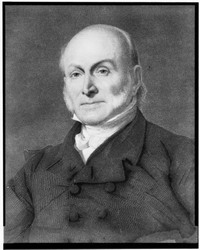Login form
John Quincy Adams

Imagine serving as a United States diplomat, member of the House of Representatives, senator, secretary of state, and president. John Quincy Adams, one of America's greatest statesmen, had all those jobs.
EARLY LIFE
John Quincy Adams was born in Braintree (now Quincy), Massachusetts, in 1767. His father was John Adams, the second president of the United States.
In 1778, during the American Revolution, ten-year-old John Quincy Adams sailed with his father to France.
The older Adams sought aid from France for America’s fight against the British. During seven years in Europe, John Quincy studied languages, politics, and science.
When he was 14, John Quincy Adams traveled to Russia as secretary to Francis Dana, the American representative in Russia.
Adams returned to the United States in 1785 to attend Harvard College. He studied law and opened a law practice. But young Adams had tasted too much excitement to settle down in a law practice!
DIPLOMAT
Adams attracted the attention of U.S. president George Washington with his articles on foreign policy. Washington knew about young Adams’s experience in Europe and named the young man a diplomat to The Netherlands in 1794. Adams later served as a diplomat in Prussia (now part of Germany).
While in The Netherlands, Adams met and married Louisa Catherine Johnson, the daughter of an American diplomat in London. The couple had three sons.
SENATOR
Adams returned to the United States after his father lost the 1800 presidential election to Thomas Jefferson. In 1803, the younger Adams won election to the U.S. Senate from Massachusetts. He had the support of the Federalist Party.
Adams kept his independence in the Senate. He broke with the Federalist Party over several issues. Adams was the only New England Federalist to vote for the Louisiana Purchase. He believed the territory would strengthen the United States, even though it would lessen the importance of New England. Many Federalists called Adams a traitor. He resigned his Senate seat in 1808.
A DIPLOMAT AGAIN
President James Madison appointed Adams U.S. representative to Russia in 1809. Over the next four years, Adams promoted American trade. He also won the friendship of Russia’s ruler, Alexander I.
In 1812, war broke out between the United States and Britain. After the war, Adams led peace negotiations. From 1815 to 1817, he served as U.S. diplomatic representative to Britain.
SECRETARY OF STATE
In 1817, President James Monroe called Adams home from Europe to serve as secretary of state. Adams’s understanding of European politics helped him do the job well. Adams worked out a treaty with Spain that gave Florida to the United States. He also won agreement from Britain that the western boundary of the Louisiana Purchase extended to the Pacific Ocean.
Adams believed the United States must stand up for itself in world affairs. He helped form a policy that became known as the Monroe Doctrine. Under this policy, the United States opposed new European colonies in North and South America. The United States also warned Europe to stay out of political affairs in the Americas.
TWO UGLY PRESIDENTIAL ELECTIONS
Adams ran for president in 1824. His opponents were Andrew Jackson, Henry Clay, and William Crawford. The election was close, and no one won a majority of the votes. Henry Clay threw his votes to Adams, and John Quincy Adams became the nation's sixth president.
Adams named Clay as his secretary of state. Jackson's supporters then accused the men of a dirty bargain. Jackson's supporters spent the next four years working against Adams and his policies.
Many of Adams's ideas were too modern for the 1820s. Adams proposed that the federal government pay for improvements that benefited all Americans, such as roads, canals, science research, and a stronger army and navy.
Adams again ran against Jackson in 1828. Each side attacked the other with rumors. Jackson claimed Adams only supported the rich and was not a friend of the people. Adams lost the election.
THE HOUSE OF REPRESENTATIVES
Bitter and sad, Adams retired to his Massachusetts home. But friends pushed him to run for the House of Representatives. Some felt this might embarrass Adams after being president, but Adams said, “No person could be degraded by serving the people as a representative in Congress.” Adams won easily.
For 17 years, Adams served in the House. One issue Adams focused on was ending slavery. For many years, Southern senators had used a “gag order” to prevent debate in Congress about ending slavery. Adams’s efforts got rid of the gag order in 1844.
Adams successfully defended the rights of some Africans illegally brought to the United States as slaves. He opposed the Mexican War in 1846, fearing that President James Polk planned to create new slave states in the West.
On February 21, 1848, 81-year-old Adams suffered a stroke while at his desk in Congress. He died two days later.
Source: Microsoft ® Encarta

